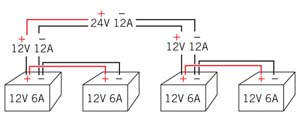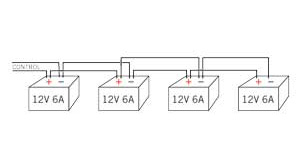1. Which of the following is not an example of a rechargeable battery?
a) Sealed lead acid
b) Ni-cad
c) Lithium ion
d) Zinc carbon
2. What is the instrument used to determine the presence, direction and strength of an electric current in a conductor?
a) Hydrometer
b) Hygrometer
c) Wheatstone Bridge
d) Galvanometer
3. What is a Voltaic Pile?
a) Abbreviation for the total “voltage compilation” on a blueprint
b) Electrons and protons arranged inside a canister
c. Layers of different metals, paper and brine
d. Volcanic ash used in battery production
4. Nominal Battery Voltage means
a) the voltage of a battery based on the number and type of cells in the battery.
b) the minimum voltage that a battery can produce before it is exhausted.
c) the voltage of a battery as determined by the manufacturer on the spec sheets.
d) the voltage of a battery based on the current output that is expected under normal conditions.
5. Overcurrent protection is
a) a fuse.
b) a circuit breaker.
c) a GFI unit.
d) none of the above
e) all of the above
7. The best way to check the condition of a standby battery is to measure its voltage when it’s not connected to anything.
a) True
b) False
6. Class 1 power limited circuits must be supplied from a power supply that limits the output to ____________ with no more than ___________.
a) 12v / 100va
b) 30v / 1000va
c) 77v / 120va
d) 24v / 10 amps
8. Calculate the required battery for the following: 1 control panel master at 340 miliamps, 2 keypads at 100 miliamps, 3 motion detectors at .2 amps, and 4 polling loop modules at .05 amps. The system should last for 24 hours. Disregard any ring time-round up.
a) 13 amps
b) 7 amps
c) 34 amps
d) 24 amps
9. According to the NEC, an emergency standby power system must have adequate capacity to carry
a) all emergency loads expected to operate simultaneously.
b) only those emergency loads that are either on constantly, or will come on under abnormal operating conditions.
c) all loads for at least 24 hours.
d) This is covered by NFPA 72, and not the NEC.
10. You can increase the standby time of a power supply by connecting batteries in series.
a) True
b) False
11. You can increase the standby time of an alarm system simply by adding sufficient batteries to the control’s power supply
a) in series.
b) of a higher voltage.
c) in parallel.
d) in the field.
12. When selecting the type of standby power system (dry cell, wet cell, generator) what factor(s) should be considered?
a) System voltage
b) Standby time required
c) Design of power supply
d) All of the above
13. Overcurrent protection devices are required for conductor from battery systems equal to or over
a) 12 volts.
b) 24 volts.
c) 50 volts.
d) 120 volts.
e) All systems
14. The amp hour (AH) rating of a battery indicates how long the battery will operate.
a) True
b) False
15. Transformers are interchangeable provided they are manufactured by the same company that provides the control panel.
a) True
b) False

|
What’s Wrong With This?
An alarm technician was completing a fire alarm installation. On the plans that the engineer provided, the battery calculation indicated a minimum 12 amp hour battery supply rated at 24 volts DC. The alarm technician didn't have the exact battery, so he looked through his truck and came up with the following configuration. The system didn't work. What did the technician do wrong?

|
Answer to: What’s Wrong With This?
The alarm technician should have purchased the correct batteries, which would have been two 12 volt, 12 amp batteries and connected them in series. However, if the alarm technician needed to connect the batteries in an emergency he could have wired them in the following fashion.
5-Minute Tech Quiz Answers
Here are the answers to 5-Minute Tech Quiz.
1) d
2) d
3) c — Invented by Alexandro Volta in 1800, it was the first electric battery.
4) a — definition from the National Electrical Code, Section 480.2
5) e
7) b — You should measure the voltage while the battery is not connected to the charging circuit, but with it connected to it’s load. This will give you an indication of the condition of the battery, not necessarily its voltage.
6) b — National Electrical Code specification in section 725.41, Remote Control, Signaling, and Power Limited Circuits.
8) c
9) a — Article 700.5(10 mandates that the system carry all loads. It does not specify and voltage or length of time.
10) b — To increase the standby time, connect the batteries in parallel within the restrictions of the control/power supply. Connecting batteries in series will increase the voltage.
11) c
12) d
13) c
14) a — The amp hour (AH) rating is an approximation of how much current the battery can supply over a period of time. In order to know how long that is, it is mandatory to perform load calculations.
15) b



